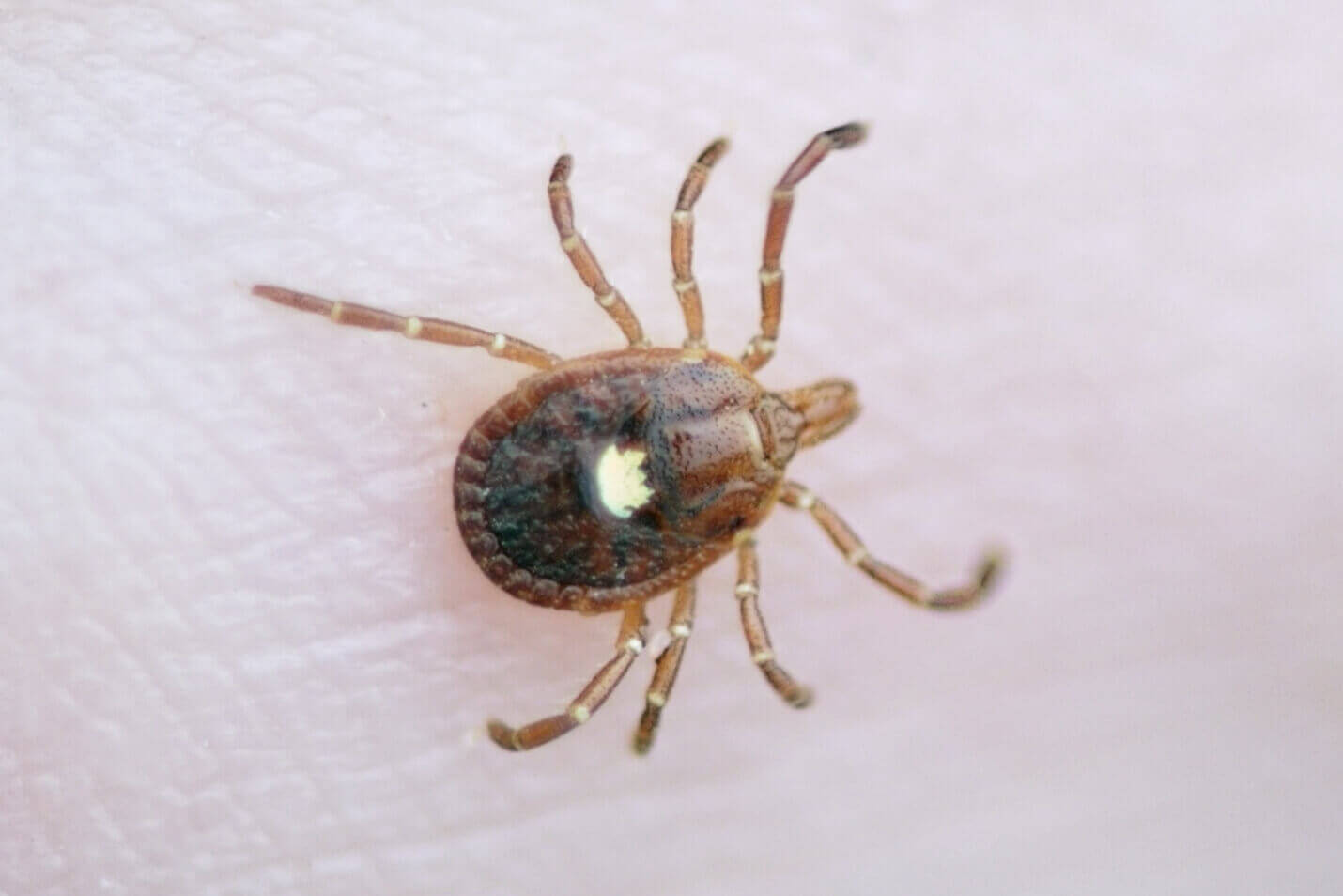Lone Star Tick Facts & Information
Everything you need to know about lone star ticks
What do Lone Star Ticks look like

Lone star ticks have reddish brown oval bodies that become slate grey when engorged. Females have a single whitish to silvery spot on their backs. Male lone star ticks have several inverted horseshoe-shaped whitish spots along their backs. The lone star tick gets its name from that single silvery-white spot located on the female’s back.
The lone star tick is a 3-host tick, with each stage requiring a different host. These ticks usually contact a host by crawling up on the tips of low-growing vegetation and waiting for a host to pass by and brush the vegetation. While larvae are almost entirely dependent on this behavior, nymphs and adults may become stimulated by the warmth and carbon dioxide from a host spending considerable time in the area and will drop to the ground, find the host, and climb onto it.
These ticks attack humans more frequently than any other tick species in the eastern and southeastern states. Lone star tick bites will occasionally result in a circular rash, and they can transmit diseases, although not Lyme disease. That’s a problem, though, because the circular rash is a common symptom of Lyme. Don’t not go to the doctor because you think it may be a lone star tick. They are not easy to identify by an untrained eye so be sure to have a Board Certified Entomologist make sure the tick you’re dealing with so you know if you need a tick exterminator.
Not the tick you have?
The lone star tick is a 3-host tick, with each stage requiring a different host. These ticks usually contact a host by crawling up on the tips of low-growing vegetation and waiting for a host to pass by and brush the vegetation. While larvae are almost entirely dependent on this behavior, nymphs and adults may become stimulated by the warmth and carbon dioxide from a host spending considerable time in the area and will drop to the ground, find the host, and climb onto it.
These ticks attack humans more frequently than any other tick species in the eastern and southeastern states. Lone star tick bites will occasionally result in a circular rash, and they can transmit diseases, although not Lyme disease. That’s a problem, though, because the circular rash is a common symptom of Lyme. Don’t not go to the doctor because you think it may be a lone star tick. They are not easy to identify by an untrained eye so be sure to have a Board Certified Entomologist make sure the tick you’re dealing with so you know if you need a tick exterminator.
Not the tick you have?
how did i get lone star ticks
Lone star ticks can’t survive inside, so if you see one in your home or business, it was probably carried in on the host they chose. They drop off when full, so if you don’t see one attached to a human or pet, that’s probably what happened. Lone star ticks cannot survive long exposure to the sun and are therefore typically found in shaded areas. The habitat must also contain both small animal hosts for larvae and large animal hosts for adults. A relative humidity of greater than 65 percent is required for egg hatch and larval survival until host attachment. A favorite habitat of the lone star tick is the woods to lawn or meadow transitional zone. You can’t control the weather, so if you have lone star ticks in your yard, it’s nothing you’re doing wrong. Only professional pest control can help with tick treatments to lower the population around your home and business.
where do lone star ticks live
Lone star ticks cannot survive long exposure to the sun and are therefore typically found in shaded areas. The habitat must also contain both small animal hosts for larvae and large animal hosts for adults. A relative humidity of greater than 65 percent is required for egg hatch and larval survival until host attachment. A favorite habitat of the lone star tick is the woods to lawn or meadow transitional zone. The lone star tick does not survive indoors. If found indoors, it was probably carried in on a pet or humans and dropped off when fully engorged.
Small animal larval hosts include the gray fox, cottontail rabbit, striped skunk, raccoon, cotton rat, gray squirrel, cat, and ground nesting birds. Nymphs get on many of these same animals, as well as larger animals typical for adults. Adult hosts include foxes, dogs, cats, cattle, white-tailed deer, wild turkey, and humans – humans are attacked by all 3 stages.
Small animal larval hosts include the gray fox, cottontail rabbit, striped skunk, raccoon, cotton rat, gray squirrel, cat, and ground nesting birds. Nymphs get on many of these same animals, as well as larger animals typical for adults. Adult hosts include foxes, dogs, cats, cattle, white-tailed deer, wild turkey, and humans – humans are attacked by all 3 stages.
what Problems do lonestar ticks cause
Patients bitten by lone star ticks will occasionally develop a circular rash similar to the rash of early Lyme disease, but it is not Lyme. They can transmit Rocky Mountain spotted fever and southern tick-associated rash illness (STARI) to both people and pets including cats and dogs. The rash may sometimes be accompanied by fatigue, headache, fever, and muscle pains.
Lone star tick bites will occasionally result in a circular rash, and they can transmit diseases. If a lone star tick is found on the body, use fine-tipped tweezers to grasp it as close to the skin’s surface as possible. Then, pull upward with steady, even pressure and avoid twisting or jerking the tick as this can cause the mouthparts to break off and remain in the skin. Once the tick is removed, thoroughly clean the bite site with soap and water. Then, flush the tick down the toilet or wrap it tightly in a tissue before disposing in a closed receptacle. If you develop a rash, headaches, pains or fever, call a doctor immediately. To avoid lone star tick bites, experts recommend wearing tick repellent and long-sleeved clothes. Avoid sitting on logs, stumps, or the ground in bushy areas. Periodically inspect clothing and the body for ticks to remove them before they become attached. Best to have tick control done by a professional so they know which tick you have and therefore which tick removal service would be best.
Lone star tick bites will occasionally result in a circular rash, and they can transmit diseases. If a lone star tick is found on the body, use fine-tipped tweezers to grasp it as close to the skin’s surface as possible. Then, pull upward with steady, even pressure and avoid twisting or jerking the tick as this can cause the mouthparts to break off and remain in the skin. Once the tick is removed, thoroughly clean the bite site with soap and water. Then, flush the tick down the toilet or wrap it tightly in a tissue before disposing in a closed receptacle. If you develop a rash, headaches, pains or fever, call a doctor immediately. To avoid lone star tick bites, experts recommend wearing tick repellent and long-sleeved clothes. Avoid sitting on logs, stumps, or the ground in bushy areas. Periodically inspect clothing and the body for ticks to remove them before they become attached. Best to have tick control done by a professional so they know which tick you have and therefore which tick removal service would be best.
how can i prevent lone star ticks
To avoid lone star tick bites, experts recommend wearing tick repellent and long-sleeved clothes. Avoid sitting on logs, stumps, or the ground in bushy areas. Periodically inspect clothing and the body for ticks to remove them before they become attached. Habitat modification and the removal of hosts are key to lone star tick removal. Keep grass cut low, and trim back vegetation along trails, paths, and yard edges. Remove debris and ground cover to discourage rodents from making your yard their home since ticks like to attach themselves to rodents.
why western for lonestar tick control
We’re passionate about controlling ticks around your home or business because we live and work here – it’s our neighborhood, too. With our almost 100 years of experience keeping homes and businesses in Connecticut, Delaware, New Jersey, New York, and Pennsylvania safe from pests, Western has the experience you can trust.
100% Satisfaction Guarantee
24-Hour Guaranteed Response
Board Certified Entomologists
Need help with lone star ticks?
GET MY QUOTE
